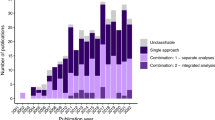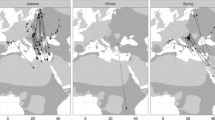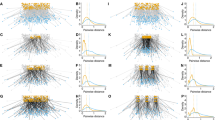Abstract
The large databases on ring reencounters, e.g. Euring database, contain extant information on the spatial distribution and potentially, on migratory connectivity of birds. However, reencounter data are normally sparse due to low reencounter probability. Further, to extract unbiased information about the spatial distribution of birds, spatial variation in reencounter probability has to be corrected for. To do so, knowledge of the total numbers of ringed birds is crucial but often not available. We present a general, combined statistical model to estimate population specific migration patterns based on the European reencounter data for which the number of ringed birds is unknown. Our approach combines a Cormack–Jolly–Seber model with a multinomial model. We present, for the first time, estimates and credible intervals of the spatial distribution of different populations of a migrant bird during the non-breeding period based on imperfect ringing data. Here, we used the Common Nightingale (Luscinia megarhynchos) as a representative long-distance migrant. The model allowed estimation of which proportions of the different breeding populations use a western, central or eastern flyway. Sensitivity analysis based on simulated data showed that most of these estimates were robust against violation of the most important model assumptions, i.e. homogeneity in recapture probability, homogeneity in breeding area return probability, and in reencounter probability within the flyways. We provide a general technique to account for spatial variation in reencounter probability when analysing migratory connectivity based on ring reencounter data with unknown numbers of ringed individuals. It is applicable for almost all migrating species with reencounter data.
Zusammenfassung
Ableitung der Zug-Konnektivität zwischen Brut- und Nichtbrutgebiet aus spärlichen Ringwiederfunddaten und unbekannter Gesamtzahl beringter Individuen
Umfassende Ringfunddatenbanken, wie die Euring-Datenbank, enthalten wertvolle Information über die räumliche Verteilung von Zugvögeln und potentiell zur Verbindungsstärke zwischen Brut- und Nichtbrutgebiet (Zug-Konnektivität). Wegen geringer Ringfundwahrscheinlichkeiten ist die Stichprobengrösse von Ringfunddaten jedoch oft klein. Wenn die räumliche Verteilung der Vögel basierend auf Ringwiederfunddaten beschrieben werden soll, muss eine räumliche Heterogenität der Ringfundwahrscheinlichkeit berücksichtigt werden. Um die Ringfundwahrscheinlichkeit schätzen zu können, sollte die Gesamtzahl beringter Vögel bekannt sein. Diese Anzahl ist jedoch in den meisten Ringfunddatenbanken nicht oder nicht detailliert enthalten. Wir stellen hier ein statistisches Modell vor, das populationsspezifische Zugmuster basierend auf den europäischen Ringfunddaten mit unbekannter Anzahl beringter Vögel zu schätzen erlaubt. Unser Ansatz beinhaltet eine Kombination eines Cormack-Jolly-Seber Modells zur Schätzung der Zahl zur Brutzeit beringter Vögel, mit einem multinominalen Modell zur Beschreibung der räumlichen Verteilung der Vögel ausserhalb der Brutzeit. Am Beispiel der Nachtigall (Luscinia megarhynchos) als typischer Langstreckenzieher präsentieren wir erstmalig Schätzwerte und Vertrauensintervalle für die räumliche Verteilung der Individuen verschiedener Populationen ausserhalb der Brutzeit, die auf nicht standardisierten Ringfunddaten basieren. Eine nachfolgende Sensitivitätsanalyse zeigte, dass die meisten Modellschätzwerte robust gegenüber Verletzungen der Modellannahmen zu homogenen Wiederfangwahrscheinlichkeiten im Brutgebiet, homogener Rückkehrrate ins Brutgebiet und homogener Wiederfundwahrscheinlichkeiten innerhalb eines Zugweges waren.



Similar content being viewed by others
References
Amrhein V, Kunc HP, Schmidt R, Naguib M (2007) Temporal patterns of territory settlement and detectability in mated and unmated Nightingales Luscinia megarhynchos. Ibis 149:237–244
Baillie S, Green RE (1987) The importance of variation in recovery rates when estimating survival rates from ringing recoveries. Acta Ornithol 23:41–60
Baillie SR, Wernham CV, Clark JA (1999) Development of the British and Irish ringing scheme and its role in conservation biology. Ring Migr 19:5–19
Baillie S, Bairlein F, Clark J, du Feu C, Fiedler W, Fransson T, Hegelbach J, Juillard R, Karcza Z, Keller LF, Kestenholz M, Schaub M, Spina F (2007) Bird ringing for science and conservation. EURING, Thetford
Baillie SR, Robinson RA, Clark JA, Redfern CPF (2009) From individual to flyways: the future of marking birds for conservation. Ring Migr 24:155–161
Bairlein F (2001) Results of bird ringing in the study of migration routes. Ardea 89(Special Issue 1):7–19
Bairlein F, Schaub M (2009) Ringing and the study of mechanisms of migration. Ring Migr 24:162–168
Bauthian I, Gossmann F, Ferrand Y, Julliard R (2007) Quantifying the origin of woodcock wintering in France. J Wildl Biol 71:701–705
Boere GC, Stroud DA (2006) The flyway concept: what it is and what it isn’t. In: Boere GC, Galbraith CA, Stroud DA (eds) Waterbirds around the world. The Stationery Office, Edinburgh, pp 40–47
Brooks S, Gelman A (1998) Some issues in monitoring convergence of iterative simulations. J Comput Graph Stat 7:434–455
Bruderer B, Liechti F (1998) Flight behaviour of nocturnally migrating birds in coastal areas—crossing or coasting. J Avian Biol 29:499–507
Burnham KP (1987) Design and analysis methods for fish survival experiments based on release-recapture. American Fisheries Society Monograph 5. American Fisheries Society, Bethesda
Burnham KP (1990) Survival analysis of recovery data from birds ringed as young: efficiency of analyses when numbers ringed are not known. Ring 13:115–132
Busse P, Kania W (1977) A quantitative estimation of distribution of ringed birds on the basis of recovery dispersal. Notatki Ornitol 18:79–93
Carothers AD (1973) The effects of unequal catch ability on Jolly-Seber estimates. Biometrics 29:79–100
Cooch E, White G (2010) Program MARK—a gentle introduction, 9th edn. http://www.phidot.org/software/mark/docs/book
Cormack RM (1964) Estimates of survival from the sighting of marked animals. Biometrika 51:429–438
Cormack RM (1972) The logic of capture-recapture estimates. Biometrics 28:337–343
Cramp S (1988) Birds of the western Palearctic, vol 5. Oxford University Press, Oxford
Gilbert RO (1973) Approximations of the bias in the Jolly-Seber capture-recapture model. Biometrics 29:501–526
Glutz von Blotzheim UN, Bauer KM (1988) Handbuch der Vögel Mitteleuropas, Band 11/I, Passeriformes (2. Teil). AULA, Wiesbaden
Grüebler MU, Naef-Daenzer B (2008) Fitness consequences of pre- and post-fledging timing decisions in a double-brooded passerine. Ecology 89:2736–2745
Grüll A (1981) Untersuchungen über das Revier der Nachtigall. J Ornithol 122:259–284
Hahn S, Bauer S, Liechti F (2009) The natural link between Europe and Africa 2.1 billion birds on migration. Oikos 118:624–626
Jolly GM (1965) Explicit estimates from capture-recapture data with both death and dilution-stochastic model. Biometrika 52:225–247
Kania W, Busse P (1986) An analysis of the recovery distribution based on finding probabilities. Acta Ornithol 23:121–128
Korner-Nievergelt F, Sauter A, Atkinson PW, Guélat J, Kania W, Kéry M, Köppen U, Robinson RA, Schaub M, Thorup K, van der Jeugd H, van Noordwijk AJ (2010a) Improving the analysis of movement data from marked individuals through explicit estimation of observer heterogeneity. J Avian Biol 41:8–17
Korner-Nievergelt F, Schaub M, Thorup K, Vock M, Kania W (2010b) Estimation of bird distribution based on ring recoveries: precision and bias of the division coefficient and its relation to multi-state models. Bird Study 57:56–68
Lebreton JD, Burnham KP, Clobert J, Anderson DR (1992) Modelling survival and testing biological hypotheses using marked animals: a unified approach with case studies. Ecol Monogr 62:67–118
Liechti F, Peter D, Lardelli R, Bruderer B (1996) The Alps, an obstacle for nocturnal broad front migration—a survey based on moon-watching. J Ornithol 137:337–356
Link WA (2003) Nonidentifiability of population size from capture-recapture data with heterogeneous detection probabilities. Biometrics 59:1123–1130
Mazzetta C (2010) Age specificity in conditional ring-recovery models. J Agric Biol Environ Stat 15:435–451
McCulloch MN, Tucker GM, Baillie SR (1992) The hunting of migratory birds in Europe: a ringing recovery analysis. Ibis 134:55–65
Morgan BJT, Ridout MS (2008) A new mixture model for capture heterogeneity. J R Stat Soc C-App 57:433–446
Nichols JD, Stokes SL, Hines JE, Conroy MJ (1982) Additional comments on the assumption of homogeneous survival rates in modern bird banding estimation models. J Wildl Manag 46:953–962
Patterson TA, Thomas L, Wilcox C, Ovaskainen O, Matthiopoulos J (2007) State-space models of individual animal movement. Trends Ecol Evol 23:87–94
Perdeck AC (1977) The analysis of ringing data: pitfalls and prospects. Vogelwarte 29:33–44
Pledger S, Pollock KH, Norris JL (2003) Open capture-recapture models with heterogeneity: I. Cormack-Jolly-Seber model. Biometrics 59:786–794
Pollock KH, Raveling DG (1982) Assumptions of modern band-recovery models, with emphasis on heterogeneous survival rates. J Wildl Manag 46:88–98
Pradel R, Hines JE, Lebreton JD, Nichols JD (1997) Estimating survival rate and proportion of transients using capture-recapture data from open population. Biometrics 53:88–99
Robinson RA, Grantham MJ, Clark JA (2009) Declining rates of ring recovery in British birds. Ring Migr 24:266–272
Royle JA, Dorazio RM (2008) Hierarchical modeling and inference in ecology. Elsevier, London
Sales DI (1973) A ring address experiment. Bird Study 20:313–314
Seber GAF (1965) A note on the multiple-recapture census. Biometrika 52:249–259
Sturtz S, Ligges U, Gelman A (2005) R2WinBUGS: a package for running WinBUGS from R. J Stat Softw 12:1–16
R Development Core Team (2009) R: a language and environment for statistical computing. R Foundation for Statistical Computing, Vienna, Austria. URL:http://www.R-project.org
Thomson DL, Cooch EG, Conroy MJ (2009) Modelling demographic processes in marked populations. Springer, New York
Thorup K, Conn PB (2009) Estimating the seasonal distribution of migrant bird species: can standard ringing data be used? In: Thomson DL, Cooch EG, Conroy MJ (eds) Modeling demographic processes in marked populations. Springer, Berlin, pp 1107–1117
Webster MS, Marra PP, Haig SM, Bensch S, Holmes RT (2002) Links between worlds: unraveling migratory connectivity. Trends Ecol Evol 17:76–83
Wernham C, Toms M, Marchant J, Clark J, Siriwardena G, Baillie S (2002) The migration atlas: movements of the birds of Britain and Ireland. Poyser, London
Wisz MS, Walther BA, Rahbek C (2007) Using potential distributions to explore determinants of Western Palaearctic migratory songbird species richness in sub-Saharan Africa. J Biogeogr 34:828–841
Zink G (1973) Der Zug europäischer Singvögel, Vol 1. Vogelzug, Möggingen
Acknowledgments
We thank the Euring team, especially Chris du Feu, for maintaining the Euring database. Thanks to all the people who helped with collecting information in the numbers of ringed Common Nightingales: Valentin Amrhein kindly provided the total number of ringed birds in the Petite Camargue Alsacienne, France. We thank Jaroslav Cepak, Wolfgang Fiedler, Olaf Geiter, Henk van der Jeugd, Wojciech Kania, Michèle Loneux, Jacques Laesser and Karcza Zsolt for providing information on the number of ringed birds. Valentin Amrhein, Lukas Jenni, Aleksi Lehikoinen, Kasper Thorup and at least two anonymous reviewers gave valuable comments on an earlier version of the manuscript.
Author information
Authors and Affiliations
Corresponding author
Additional information
Communicated by F. Bairlein.
Electronic supplementary material
Below is the link to the electronic supplementary material.
Rights and permissions
About this article
Cite this article
Korner-Nievergelt, F., Liechti, F. & Hahn, S. Migratory connectivity derived from sparse ring reencounter data with unknown numbers of ringed birds. J Ornithol 153, 771–782 (2012). https://doi.org/10.1007/s10336-011-0793-z
Received:
Revised:
Accepted:
Published:
Issue Date:
DOI: https://doi.org/10.1007/s10336-011-0793-z




